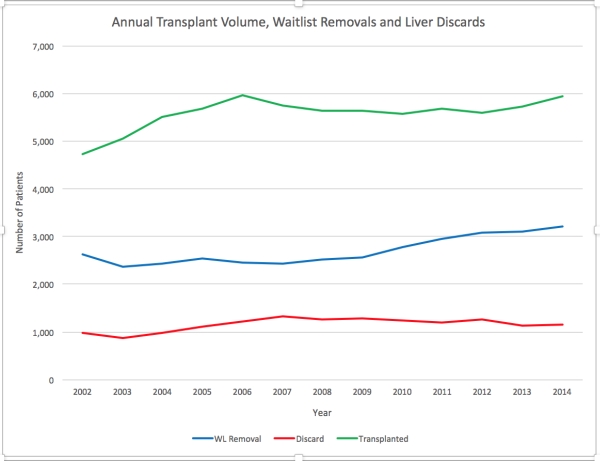Skeletons in the Closet? An Insight into Donor Liver Discards in the US
Weill Cornell Medicine, NY, NY.
Meeting: 2018 American Transplant Congress
Abstract number: 422
Keywords: Donation, Graft acceptance, Liver transplantation
Session Information
Session Name: Concurrent Session: Donor Management: All Organs Excluding Kidney
Session Type: Concurrent Session
Date: Tuesday, June 5, 2018
Session Time: 2:30pm-4:00pm
 Presentation Time: 3:30pm-3:42pm
Presentation Time: 3:30pm-3:42pm
Location: Room 3AB
Background Liver discards are poorly investigated. Among these discarded livers are potentially useable grafts that could save the lives of many of the 2500-3000 who are removed annually from waiting lists (WL) due to death or medical deterioration. We aimed to investigate the patterns of liver discards in US in the MELD era.
Methods Analysis of a UNOS STAR file of all deceased donor organs from Jan 2002 to June 2015. Due to high discard rates, DCD donors were excluded.
Results A total of 92,967 deceased donor livers were considered for transplantation, of these 75,582 (81.3%) were transplanted, and the remaining 17,385 (19.7%) were discarded at various points in the donation process. Over the same time period, 22,845 patients died on the list, and a further 13,722 were removed due becoming too sick. 7,678 (44.2%) were discarded pre-recovery (Pre-D). The most common reasons for Pre-D were pre-recovery biopsy (Bx) findings (17.2%) or poor organ function (15.7%). 9,707 (55.8%) livers were discarded intraoperatively (Intra-D). Bx findings accounted for 39% of these discards (n=3,751). Interestingly, of the livers discarded with available Bx, 70% had ≤30% macrosteatosis; steatosis being the only Bx data available from UNOS. Surprisingly, 30.5% of all liver discards were in donors ≤40 years of age, and 80% in donors ≤60. <10% of Pre-D and Intra-D livers were HCV/HBV positive. There was significant regional variation in discard rates, with regions 2 & 6 having the highest rates (23.2% and 23%.1 respectively), and regions 8 & 3 the lowest (15.1% & 15.5%), p<0.001. Discard rates were not associated with overall donor volume explored. Figure-1 demonstrates that despite a rise in WL removals due to death/deterioration, liver discard rates have been steady at 6-8% annually.
Conclusion Substantial numbers of livers are discarded. Discards occur frequently in donors who are relatively young, and in livers that do not demonstrate significant macrosteatosis. Regional variation in liver discards suggests that policy improvements can be made to minimize discard rates, and maximize the use of potentially useable to alleviate the rising WL mortality/removal rate.
CITATION INFORMATION: Halazun K., Rana A., Roll G., Tabrizian P., Agopian V., Samstein B., Brown R., Emond J. Skeletons in the Closet? An Insight into Donor Liver Discards in the US Am J Transplant. 2017;17 (suppl 3).
To cite this abstract in AMA style:
Halazun K, Rana A, Roll G, Tabrizian P, Agopian V, Samstein B, Brown R, Emond J. Skeletons in the Closet? An Insight into Donor Liver Discards in the US [abstract]. https://atcmeetingabstracts.com/abstract/skeletons-in-the-closet-an-insight-into-donor-liver-discards-in-the-us/. Accessed January 8, 2026.« Back to 2018 American Transplant Congress
